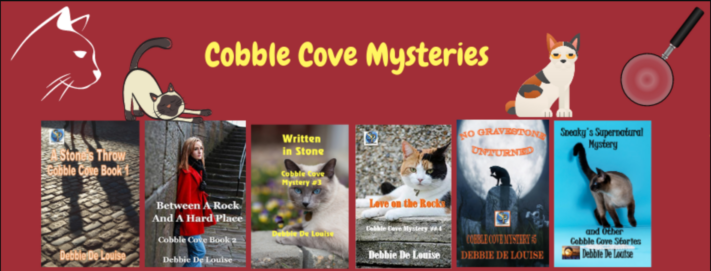Cats have been popular in literature for ages. Children’s books often feature them, as do cozy mysteries, and other novels. Why? Because people love cats. They can add humor and humanity to a story. With their unique purr-sonalities and mystical natures, they make purr-fect characters to write about.
Before we talk about how and why to add cats to your fiction writing, let’s look at the types of cat characters that can appear…

4 Types of Cat Characters that Appear in Fiction Writing
1. Main Character Cats (M.C. Cats)
In Children’s books, cats are often main characters such as Puss-in-Boots, Cat in the Hat, and Pete the Cat. Cats also play starring roles in adult books, fiction as well as non-fiction. Check this Goodreads list for Books with Cats As Main Characters:
2. Supporting Character Cats
Most cozy mysteries include a cat co-star. These cats help the main character or amateur sleuth find clues to the mystery. Examples of these felines are Midnight Louie in Carole Nelson Douglas’ series and Joe Grey from Shirley Murphy’s books. In my Cobble Cove mysteries, Sneaky the Siamese library cat assists Alicia, the librarian, solve murders in the small town of Cobble Cove.
3. Subplot Cats
There are books where cats play roles in a subplot, while not being featured as main characters or co-stars. For instance, in my book, Memory Makers, Lauren, a kidnapping investigator, rushes home from the clinical trial in which is participating to find her missing cat, Harry. In doing so, she also locates a missing boy. The main mystery involves the clinical trial where Lauren is seeking to recall the man who kidnapped her and her sister twenty years ago and killed her sister. Her missing cat is a subplot to this mystery.
4. Cameo Cats
Cats can also make cameo appearances in books and stories when an author features the cat as a pet without any connection to a mystery or any significant role in the plot. An example of a book that I read where this happened was the popular, Where the Crawdads Sing by Delia Owens. The cat appeared toward the end of the book when it served to soothe the main character, Kya, while she was in jail.
Once you decide what type of cats you want to feature in your writing, you need to decide whether they will speak or only make feline sounds. In cozy mysteries where the cat is the sleuth’s co-star, they usually help the main character locate clues with non-verbal actions. In A Stone’s Throw, the first book of my Cobble Cove mysteries, Sneaky alerts Alicia to hidden letters by scratching the box in which they’re hidden. Later in the series, Sneaky converses with his fellow pet characters but still only uses cat behavior to lead Alicia to clues.

How do you work cats into your plots?
I model my cat characters after my own cats. I use their antics and personalities to make them real to readers. In my first novel, Cloudy Rainbow, Floppy, who was named after my own cat, burrows himself into Dulcie’s mattress and falls asleep. When she finally finds him, she worries he’d smothered because he wasn’t moving. In a panic, she sliced through the mattress with a knife. I did the same thing when Floppy was a kitten.
In my Cobble Cove books, after I introduced KittyKai, the female cat, I gave her my own calico Hermione’s personality traits and also added some human female characteristics. KittyKai, joining Sneaky on a mission to find a killer, jumps into a woman’s bedroom and begins grooming herself on the woman’s vanity.
KittyKai and Sneaky have a love/hate relationship but, one night following a successful adventure, they walk over a moonlit bridge where fish are swimming and have a romantic encounter. In No Gravestone Unturned, when Sneaky and KittyKai are joined by Salem, the cat of a guest at the inn where KittyKai lives, the three end their story by jumping and rolling in autumn leaves. My cats are indoor cats, but if they went outdoors that was something I’m sure they’d enjoy doing.
Fictionalizing yet retaining the real actions and personalities of the cats you write about helps readers identify with their own pets and also allows them to enjoy the other elements of the story.
About the Author

Debbie De Louise is a retired librarian and an award-winning author. Her writing includes the Cobble Cove and Buttercup Bend cozy mystery series and other novels, short stories, poems, articles, and a novella. Her Cobble Cove cozy mystery series featuring Alicia the librarian and Sneaky the library cat, is published by Solstice Publishing and consists of six books. Her new Buttercup Bend series featuring Cathy Carter, the co-owner of a pet rescue center and pet cemetery, is published by Next Chapter Publishing and includes The Case of the Cat Crazy Lady and The Case of the Parrot Loving Professor. She is currently working on the third book, The Case of the Llama Raising Librarian.
Debbie is a member of Sisters-in-Crime, International Thriller Writers, and the Cat Writers’ Association. She lives on Long Island with her husband, daughter, and two cats.
The courthouse/jailhouse cat in Where The Crawdads Sing was a wonderful example of a subplot cat.
Thanks, Kathy. I zeroed in on the cat immediately, although I loved that whole book.
I was surprised ‘talking cats’ seem to frustrate some people, I find them intriguing and fun. Joe Grey, for eample, was beautifully characterised and I can imagine him, like you describe, being based on a real cat.
Terrific article! Though I’m writing nonfiction narratives that portray cats mainly through their natural actions, I found myself voicing them at times. Whether or not to do that is an intriguing question. In my case a big imposing cat named Bud started smarting off to me and it kept going from there …
That’s an interesting way to handle cats in NF. I may have look into that in future books.
Great post Debbie. I never thought about how authors characterize the cats in novels but now I see the different categories. Interesting.
Sorry I didn’t see this before, Andrea. There was some precedent that made me feel sort of okay about it in nonfiction. British humorist Deric Longden wrote nonfiction about his cats and voiced them occasionally. I think it was either in The Cat Who Came In From The Cold, or Enough To Make A Cat Laugh. I can’t recall which at this time, or if it was one or more of his other books.
Lovely post! I’m working on a short story collection, adding subplot and cameo cats, and I appreciate your perspective on the topic.
A brilliant example of a subplot cat is in The Third Man, a book which was turned into the classic film with Orson Welles. In one scene we learn from Harry Lime’s girlfriend that her cat only ever liked Harry. At this point the audience/reader believes Harry to be dead. Then we see her cat walking down a dark street where a shadowy figure hovers in a doorway. The cat rubs lovingly against the figure’s brogues. It’s a pivotal scene in which it slowly dawns on the audience/reader that the shadowy figure is Harry, who is in fact very much alive. It’s such a clever drum roll moment!
A thoroughly enjoyable read. I’ve been trying to figure why Earl Derr Biggers, author of the Charlie Chan series (1925-1932) added “Egbert” a black cat at the beginning of his 3rd novel, Behind That Curtain (1928). Now, thanks to your post I’ve found an answer. Thank you so much. Lou